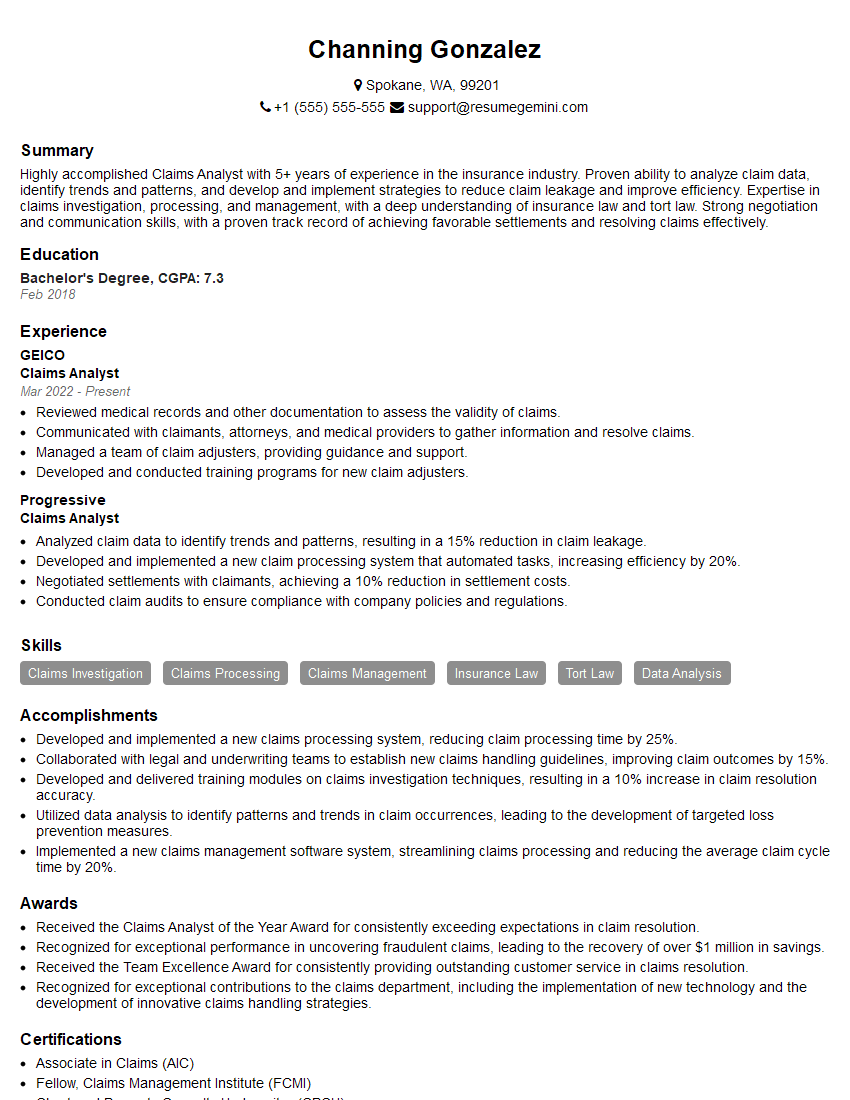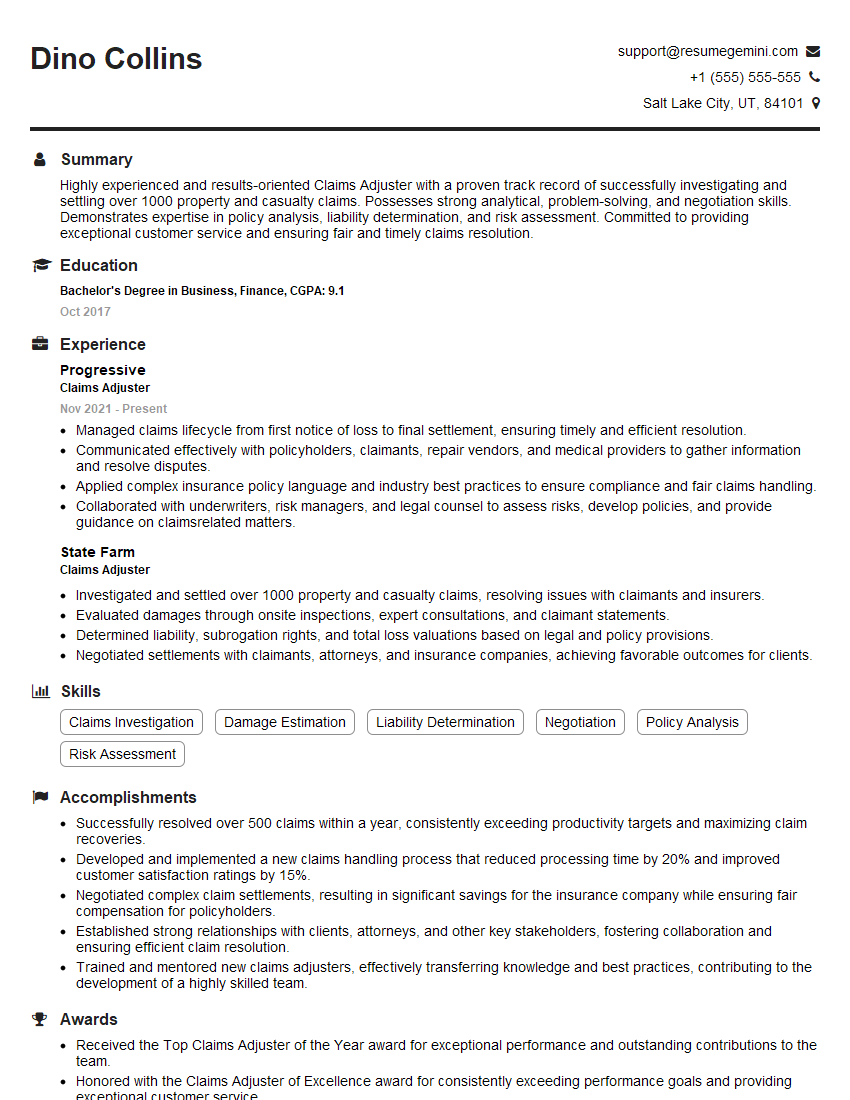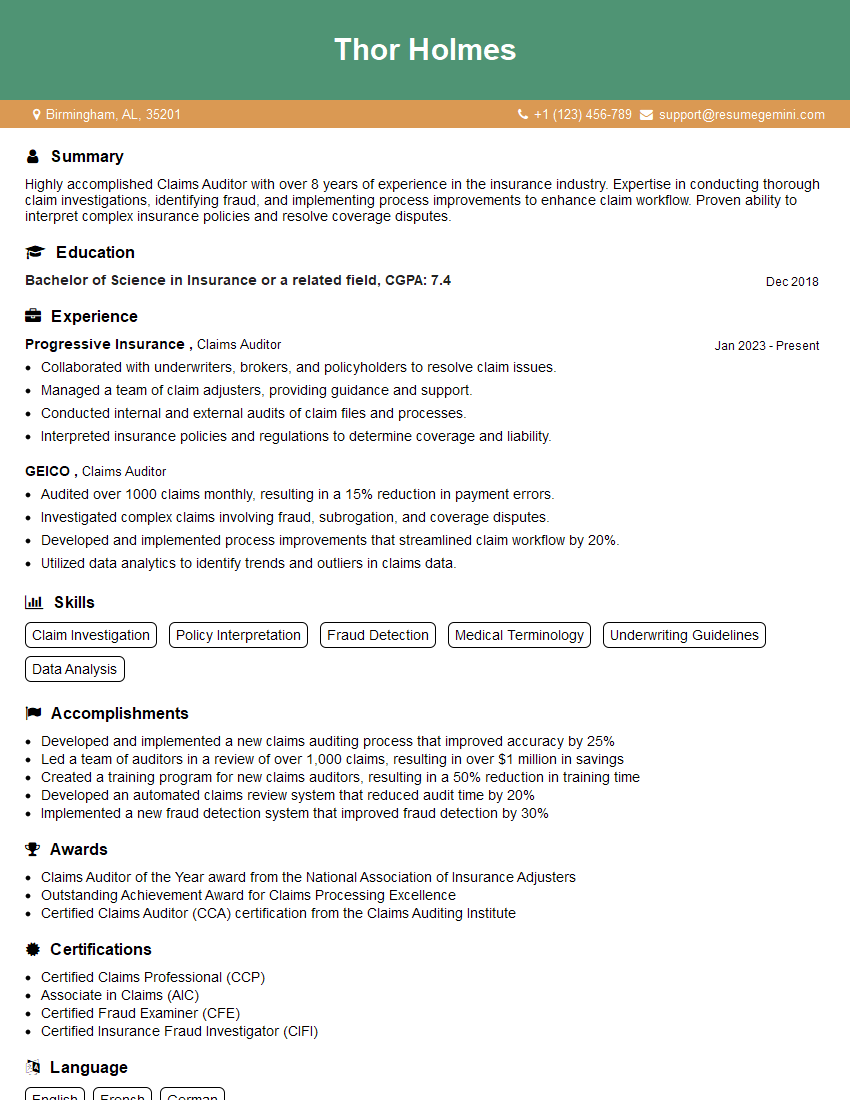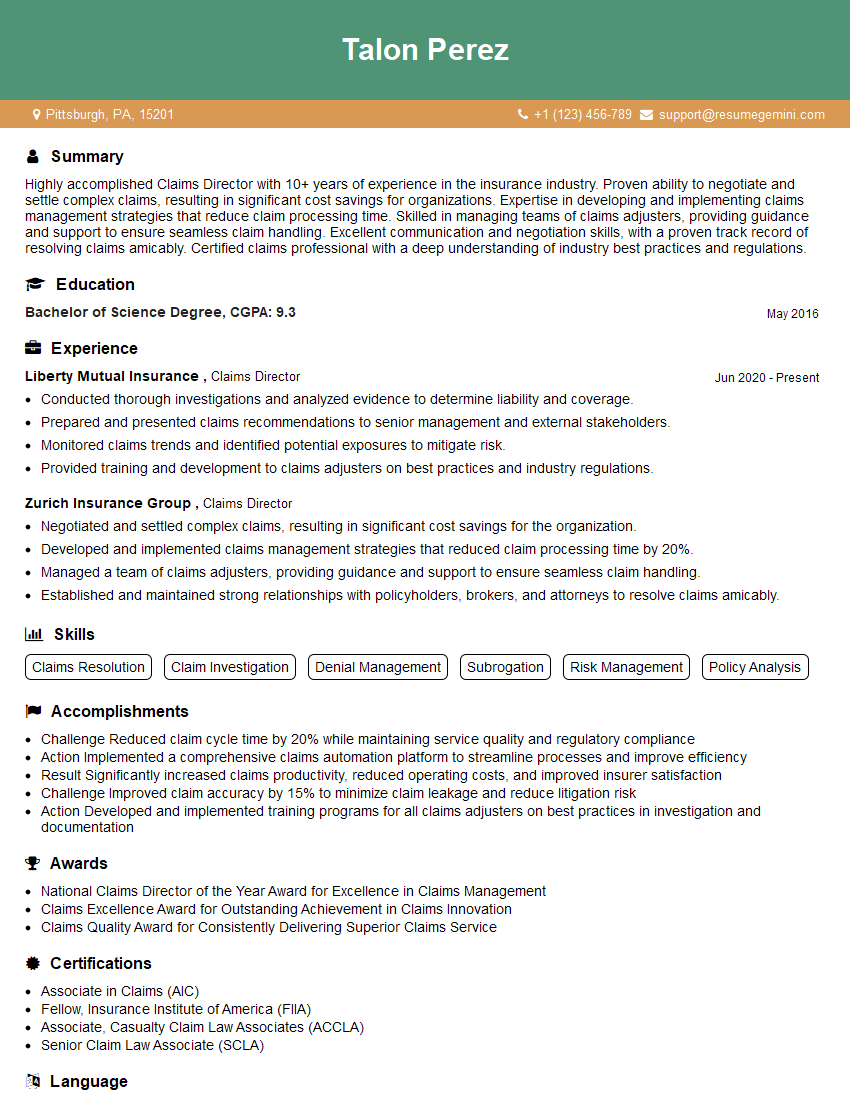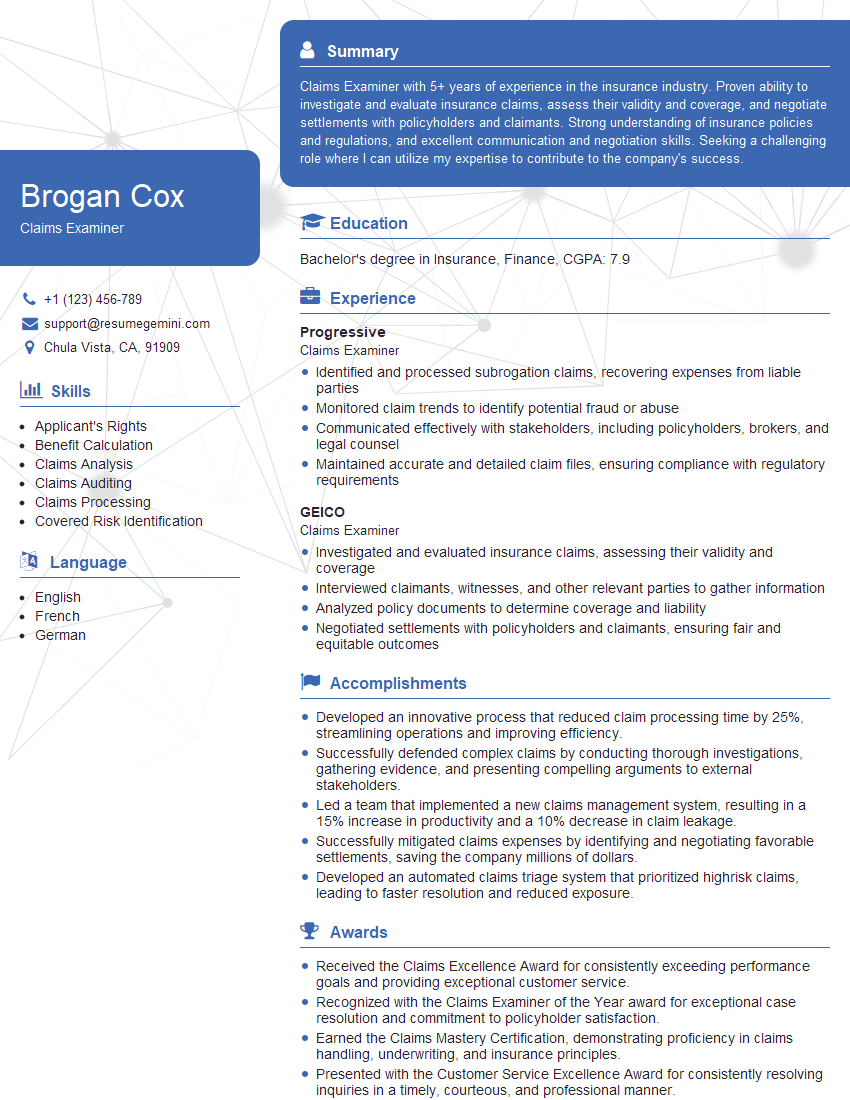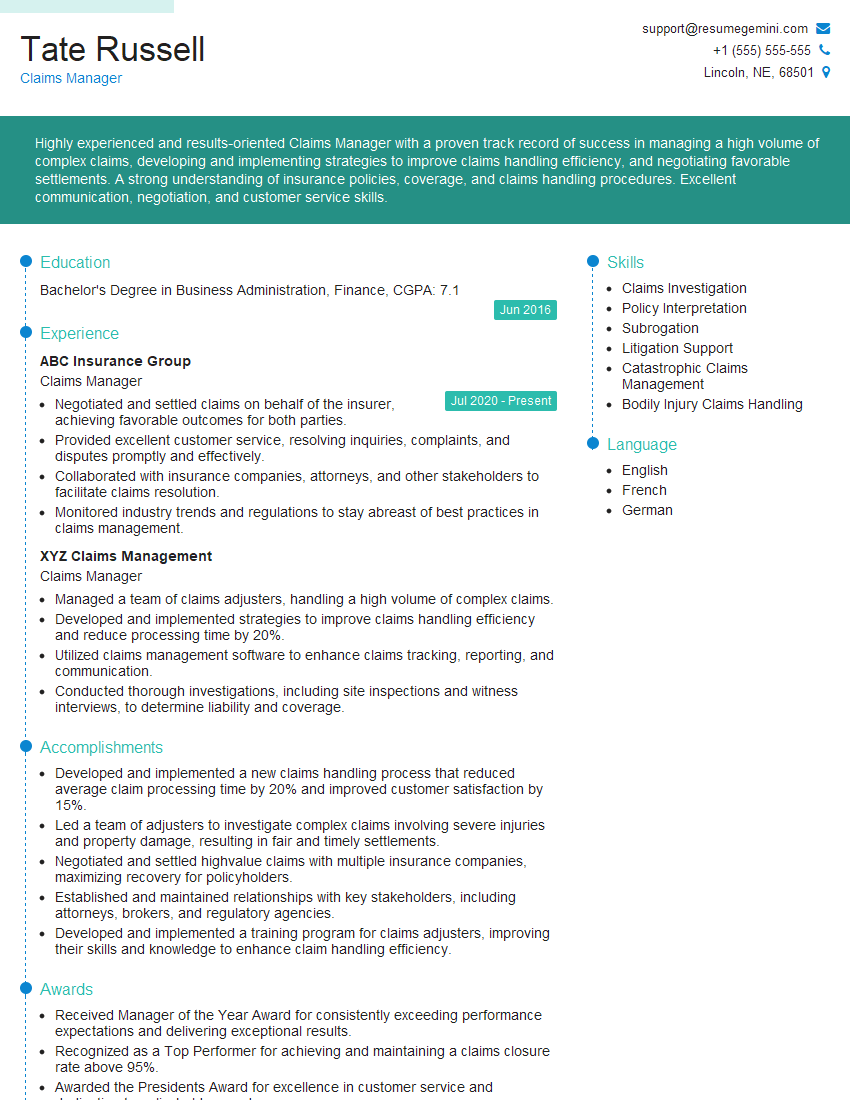Feeling uncertain about what to expect in your upcoming interview? We’ve got you covered! This blog highlights the most important Claim Flow interview questions and provides actionable advice to help you stand out as the ideal candidate. Let’s pave the way for your success.
Questions Asked in Claim Flow Interview
Q 1. Explain the claim flow process from initiation to closure.
The claim flow process, from initiation to closure, is a structured journey designed to efficiently and fairly resolve claims. Think of it like a well-oiled machine, with each part contributing to a smooth final output. It typically begins with the claimant submitting a claim – this could be anything from an insurance claim for a car accident to a reimbursement request for an expense. Next, the claim is received and registered, undergoing preliminary checks for completeness and accuracy. Then, it moves into processing, which includes verification of information, investigation if needed, and assessment of liability. Following this, a decision is made whether to approve or deny the claim, with reasons clearly communicated to the claimant. Finally, the claim is closed, often with payment or a final explanation issued. Throughout the entire process, various stakeholders – adjusters, supervisors, legal teams – may be involved, each playing a crucial role in ensuring the claim is handled effectively and within regulatory compliance.
- Claim Submission: Claimant files a claim.
- Claim Registration & Preliminary Checks: Claim data is entered and validated.
- Claim Processing & Investigation: Verification, data gathering, and assessment take place.
- Claim Decision & Communication: Claim is approved or denied; notification is sent to the claimant.
- Claim Closure: Payment is processed, or a final explanation provided. Documentation is archived.
Q 2. Describe your experience with different claim handling systems.
I’ve had extensive experience with a variety of claim handling systems, ranging from legacy systems to modern, cloud-based platforms. For example, I worked with a legacy system based on mainframe technology – a complex system with limited automation, requiring significant manual data entry and prone to integration challenges. This experience highlighted the need for robust data management and thorough documentation. In contrast, I’ve also used sophisticated, user-friendly platforms incorporating workflow automation, AI-powered fraud detection, and real-time analytics dashboards. These systems have revolutionized claim processing, significantly reducing turnaround time and improving overall efficiency. My experience also encompasses systems specialized for specific claim types, like healthcare claims processing software adhering to HIPAA compliance rules, or property and casualty systems designed to manage complex damage assessments.
Q 3. How do you prioritize claims based on urgency and complexity?
Prioritizing claims involves balancing urgency and complexity. I typically use a matrix system. Claims are categorized based on two factors: urgency (e.g., immediate medical needs, potential for significant financial loss) and complexity (e.g., involvement of multiple parties, extensive documentation required). Claims with high urgency and high complexity are naturally given top priority. Think of a patient requiring immediate surgery versus a simple reimbursement request. The high-urgency, low-complexity claims might be processed swiftly by automation, while those in the low-urgency, high-complexity category might require more careful planning and investigation. This structured approach ensures that critical cases are addressed promptly while ensuring that no claim falls through the cracks.
Q 4. What metrics do you use to measure the efficiency of a claim flow process?
Measuring the efficiency of claim flow requires a multi-faceted approach, utilizing key performance indicators (KPIs). These include:
- Average Handling Time (AHT): The average time taken to process a claim from initiation to closure.
- Claim Cycle Time: The time taken to complete the entire claim processing cycle.
- First Contact Resolution (FCR): The percentage of claims resolved on the first contact with the claimant.
- Claim Closure Rate: The percentage of claims successfully closed within a given period.
- Error Rate: The percentage of claims with processing errors.
- Customer Satisfaction (CSAT): Measures claimant satisfaction with the claim handling process.
By tracking and analyzing these metrics, we can identify areas for improvement and optimize the claim flow process for efficiency and customer satisfaction.
Q 5. How do you identify and resolve bottlenecks in the claim flow?
Identifying and resolving bottlenecks in claim flow often requires a systematic approach. I usually start by analyzing the KPIs mentioned earlier; a significant increase in AHT or a decrease in FCR could point to bottlenecks. Then, I delve deeper using process mapping and workflow analysis to pinpoint specific stages experiencing delays. This could involve examining individual claim files, interviewing stakeholders, and reviewing system logs. Once the root cause is identified – whether it’s an outdated system, inadequate staffing, or inefficient processes – I develop and implement targeted solutions. These might include automation of manual tasks, process optimization, employee training, or system upgrades. Regular monitoring of KPIs is crucial to ensure that the implemented solutions are effective.
Q 6. Describe your experience with claim audits and reconciliation.
Claim audits and reconciliation are critical for ensuring accuracy and compliance. Audits involve a systematic review of a sample of claims to identify errors, irregularities, or potential fraud. Reconciliation focuses on comparing the claim data with other relevant information, such as payment records or medical bills, to ensure consistency and accuracy. I have experience conducting both pre-payment and post-payment audits, utilizing various audit techniques and tools. For example, I used data analytics software to identify patterns of potential fraud in a large set of claims, leading to the recovery of significant funds. Regular audits and reconciliations are vital for maintaining the integrity of the claim flow process and protecting both the claimant and the organization.
Q 7. How do you handle complex or disputed claims?
Complex or disputed claims require a methodical and thorough approach. My strategy typically involves a structured escalation process. The first step involves a detailed review of all available documentation to fully understand the claim and the reasons for the dispute. Then, I gather additional information, if needed, by interviewing witnesses or consulting with experts. For example, in a property damage claim with differing opinions on the extent of damage, I’d arrange for an independent assessment. Throughout this process, clear and consistent communication with the claimant is key. If the dispute cannot be resolved internally, we might explore alternative dispute resolution mechanisms, such as mediation or arbitration. Legal counsel might be required in more complex situations. Ultimately, a fair and transparent resolution is the goal, ensuring both the claimant and the organization feel heard and understood.
Q 8. What is your experience with fraud detection and prevention in claim flow?
Fraud detection and prevention are critical in claim flow to protect the financial health of the organization and ensure fairness to legitimate claimants. My experience involves implementing and managing various fraud detection strategies, ranging from rule-based systems to sophisticated machine learning models.
For example, I’ve worked with systems that flag claims with unusual patterns, such as multiple claims from the same IP address or claims with suspiciously similar details. We also utilize data analytics to identify outliers and anomalies in claim data, which can signal potential fraudulent activity. These systems often involve analyzing claim information like dates of service, provider information, and claimant demographics to identify red flags. Beyond automated systems, I’ve also been involved in training teams to recognize common fraud schemes and conducting thorough claim investigations when suspicions arise. A robust investigative process is key to validating findings and taking appropriate action.
Further, I have extensive experience in collaborating with law enforcement agencies when necessary to pursue legal action against individuals involved in fraudulent activities. This includes preparing detailed reports and providing testimony when required.
Q 9. How do you ensure compliance with regulatory requirements in claim processing?
Compliance with regulatory requirements is paramount in claim processing. My approach involves a deep understanding of relevant regulations, such as HIPAA for health claims, and state-specific regulations for auto or workers’ compensation claims. This understanding guides the development and implementation of internal processes and procedures.
We maintain comprehensive documentation of our compliance measures, including regular audits and training programs for our staff. Our procedures encompass secure data handling, accurate claim documentation, and timely reporting to regulatory bodies. For instance, ensuring proper authorization and verification of patient information before processing a health claim is critical to comply with HIPAA. We leverage specialized software to automate many aspects of regulatory compliance, ensuring all claims meet the necessary criteria before being processed. This also includes the use of regularly updated compliance checklists, which help us proactively identify and address potential compliance gaps.
Q 10. Explain your experience with different claim types (e.g., auto, health, workers’ comp).
I have extensive experience across diverse claim types, including auto, health, and workers’ compensation. Each type presents unique challenges and requires specialized knowledge.
- Auto Claims: My experience encompasses handling claims involving property damage, bodily injury, and uninsured/underinsured motorist coverage. This includes assessing liability, negotiating settlements, and managing litigation when necessary. I’m familiar with various state-specific regulations governing auto insurance.
- Health Claims: I’m proficient in processing claims involving various medical services, including inpatient and outpatient care, physician visits, and prescription drugs. Understanding medical coding and billing procedures, along with payer specific requirements, is a key part of this. Ensuring adherence to HIPAA regulations is critical here.
- Workers’ Compensation Claims: This involves managing claims related to workplace injuries and illnesses. This requires understanding the legal framework of workers’ compensation, including state-specific laws, and coordinating with medical providers and employers.
In all claim types, I focus on accurate and timely processing, ensuring claimants receive fair and equitable treatment while adhering to regulatory guidelines and organizational policies.
Q 11. How do you utilize technology to improve claim flow efficiency?
Technology plays a pivotal role in enhancing claim flow efficiency. I’ve worked with various technological solutions, including:
- Claim Management Systems (CMS): These systems streamline the entire claim lifecycle, from initial intake to final settlement. They automate tasks like data entry, claim routing, and communication with stakeholders, reducing manual effort and processing times. Examples include Guidewire and ClaimCenter.
- Optical Character Recognition (OCR): OCR software automatically extracts data from claim documents, reducing manual data entry and improving accuracy. This significantly speeds up the processing of paper-based claims.
- Data Analytics and Business Intelligence (BI): These tools provide insights into claim patterns, trends, and potential areas for improvement. We use them to identify bottlenecks, optimize workflows, and improve overall efficiency. Data analysis helps us predict future claim volumes and resource allocation.
- Robotic Process Automation (RPA): RPA bots can automate repetitive, rule-based tasks, such as data validation and claim routing, freeing up human resources for more complex tasks.
By strategically integrating these technologies, we’ve significantly reduced processing times, improved accuracy, and enhanced the overall claimant experience.
Q 12. Describe your experience with claim documentation and record keeping.
Meticulous claim documentation and record-keeping are vital for legal compliance, auditing purposes, and effective claim management. My experience includes developing and implementing robust document management systems, ensuring all claim-related information is securely stored and readily accessible. This includes both electronic and physical records.
We utilize secure electronic document management systems to store and manage all claim files. These systems offer features such as version control, access control, and robust search capabilities. All documents are indexed and organized using a consistent naming convention for easy retrieval. We maintain a detailed audit trail of all access and modifications to ensure data integrity and accountability. For physical documents, we employ secure storage facilities with controlled access to comply with regulatory requirements and prevent loss or damage.
Q 13. How do you communicate with claimants and other stakeholders throughout the claim process?
Effective communication is essential throughout the claim process. I strive to maintain open and transparent communication with claimants and other stakeholders. This involves clearly explaining the claim process, providing regular updates on progress, and promptly responding to inquiries.
We utilize a multi-channel communication strategy, including phone calls, emails, and secure online portals. Claimants can access their claim information online, track progress, and submit documents electronically. We also use automated email notifications to inform claimants of key milestones in the process. For complex cases or those requiring a more personal touch, we often schedule phone calls or in-person meetings to address specific questions and concerns. Building a strong rapport with claimants is crucial for fostering trust and managing expectations.
Q 14. What is your experience with claims reserving and forecasting?
Claims reserving and forecasting are crucial for accurate financial planning and risk management. My experience involves using various actuarial methods to estimate the ultimate cost of outstanding claims. This involves analyzing historical claim data, considering factors such as claim severity, frequency, and inflation, and developing models to predict future claim payouts.
I’ve utilized statistical modeling techniques, such as generalized linear models (GLMs) and stochastic reserving methods, to develop accurate and reliable reserves. These models take into account various factors that can influence claim costs, such as the type of claim, the claimant’s age and medical history (for health claims), and the severity of the injury (for workers’ compensation claims). Regular monitoring and adjustments are made to ensure the reserves remain accurate and reflect the latest trends and developments. This information is essential for setting appropriate premiums, managing financial risk, and making informed business decisions.
Q 15. How do you manage claim denials and appeals?
Managing claim denials and appeals requires a systematic approach focused on understanding the reasons for denial and crafting a compelling appeal. First, I meticulously review the denial reason code and accompanying explanation from the payer. This often involves cross-referencing with the claim documentation, medical records, and the payer’s specific guidelines. For example, a denial might be due to a missing authorization, a coding error, or insufficient medical documentation.
Once the reason is identified, I develop a strategy. This could involve correcting the coding, providing additional documentation like a physician’s letter clarifying the medical necessity, or submitting an internal appeal within the organization if there’s a discrepancy. External appeals to the payer require carefully constructing a letter that addresses each point of denial with evidence, following the payer’s specific appeal process. I always maintain detailed records of each appeal step, including dates, communications, and outcomes, ensuring complete transparency and facilitating future reference. In cases of persistent denials, I escalate to a senior claims specialist or legal counsel, if necessary.
Consider this example: A claim for physiotherapy was denied due to lack of pre-authorization. My strategy would involve first confirming whether pre-authorization was indeed required according to the payer’s policy. If so, I would then either submit the missing authorization request (if the treatment is still ongoing), or provide documentation from the physician explaining why it was medically unnecessary, thus justifying the retroactive authorization.
Career Expert Tips:
- Ace those interviews! Prepare effectively by reviewing the Top 50 Most Common Interview Questions on ResumeGemini.
- Navigate your job search with confidence! Explore a wide range of Career Tips on ResumeGemini. Learn about common challenges and recommendations to overcome them.
- Craft the perfect resume! Master the Art of Resume Writing with ResumeGemini’s guide. Showcase your unique qualifications and achievements effectively.
- Don’t miss out on holiday savings! Build your dream resume with ResumeGemini’s ATS optimized templates.
Q 16. Explain your experience with claims reporting and analysis.
Claims reporting and analysis are crucial for identifying trends, improving efficiency, and reducing financial losses. My experience encompasses using various reporting tools and techniques to extract, analyze, and interpret claims data. I’m proficient in using SQL to query databases and extract specific claim attributes, such as denial reasons, processing times, and payment amounts. I can then use tools like Excel or specialized business intelligence software to visualize this data in meaningful ways, creating reports, charts, and dashboards to track key performance indicators (KPIs).
For example, I might analyze denial reasons to identify recurring patterns. If I see a high number of denials due to incorrect coding, I would then work with the coding team to implement training or process improvements. Similarly, analyzing processing times allows us to identify bottlenecks and streamline workflows. I utilize this analysis to identify cost savings opportunities, and to proactively address potential problems that could lead to more denials or longer processing times. The resulting insights are crucial for optimizing our claims processing and maximizing reimbursement rates.
Q 17. Describe your experience working with claims teams and other departments.
Collaboration is key in claims processing. My experience involves working closely with various teams, including medical records, provider relations, and billing departments. With the medical records team, I frequently coordinate to obtain missing or incomplete medical documentation required to process claims. With the provider relations team, I work to resolve disputes or issues with providers to ensure smooth claim submission. And with the billing department, I ensure accurate billing practices are followed to avoid denials.
I view myself as a facilitator, connecting these departments to achieve shared goals. Effective communication, particularly clear and timely updates, are essential to maintain a positive working relationship. I use project management techniques to track progress on complex cases and provide regular updates to stakeholders. For example, if a claim is delayed because of missing information, I proactively communicate with the relevant teams, outlining the issue and the steps needed to resolve it, setting clear expectations for timelines and keeping all involved informed.
Q 18. How do you handle high-volume claim workloads?
Handling high-volume claim workloads requires a combination of efficient processes, technological tools, and effective prioritization. I utilize workflow management software to track claims through their various stages, ensuring no claim falls through the cracks. Automating tasks where possible, such as data entry and basic verification checks, frees up time for more complex tasks. Prioritization is crucial – I focus on time-sensitive claims requiring urgent action, such as those involving critical patient care or those with imminent deadlines for appeals.
Furthermore, I use data analysis to identify the root causes of processing delays. For instance, I may discover a specific payer consistently takes longer to process claims, requiring a shift in my strategy to focus on other tasks while these claims are pending. I may also identify patterns of error in specific claim types and proactively address these issues, preventing future delays. Effective teamwork is essential. By distributing tasks efficiently amongst colleagues and seeking support when needed, I ensure the workload is managed effectively and efficiently, while maintaining accuracy and quality.
Q 19. How do you ensure data accuracy and integrity in claim processing?
Data accuracy and integrity are paramount in claims processing. I employ several strategies to ensure this. First, I utilize automated data validation checks throughout the claim processing workflow. This includes verifying data fields for accuracy and consistency, checking for missing or invalid information, and identifying potential errors early on. Second, I perform regular audits to compare claim data against source documents, such as medical records and provider contracts. This helps catch discrepancies and inconsistencies.
For example, I might regularly compare the codes billed on a claim against the physician’s notes to confirm accuracy and consistency. Any discrepancies found are investigated thoroughly and rectified. Third, I adhere to strict data security protocols to protect sensitive patient information. This involves following HIPAA compliance regulations and using secure systems for data storage and transmission. Regular training on data security best practices is crucial to maintain proficiency. The goal is to minimize the risk of errors, fraud, and non-compliance.
Q 20. What is your experience with claim system implementation or upgrades?
I have extensive experience with claims system implementations and upgrades. This includes participating in requirements gathering sessions, testing new systems, and providing training to colleagues. My involvement in system upgrades typically begins with an assessment of the current system’s limitations and the needs of the organization. I help identify the optimal features in new software. During the implementation phase, I contribute to data migration, ensuring a smooth transition and minimal disruption to the processing workflow.
Testing is critical. I conduct rigorous testing to identify and fix bugs before the system goes live. Post-implementation, I provide ongoing training and support to staff, resolving any questions or issues that may arise. I also help to develop and maintain documentation outlining system workflows and processes. For instance, in a recent system upgrade, I played a key role in designing a comprehensive training program for staff, reducing errors and improving efficiency. A successful implementation relies on meticulous planning, comprehensive testing, and proactive training to minimize disruption and maximize efficiency.
Q 21. How do you contribute to a positive claimant experience?
Contributing to a positive claimant experience is a top priority. This involves clear, proactive communication, timely processing of claims, and empathetic handling of inquiries. I strive to keep claimants informed of the status of their claims at each stage, providing regular updates and promptly responding to their questions or concerns. I treat each claimant with respect and understanding, recognizing that dealing with insurance claims can be a stressful time.
For example, I might send an automated email acknowledging receipt of a claim, followed by another update once it is processed. If a claim is delayed, I proactively contact the claimant to explain the reason for the delay and provide an estimated timeframe for resolution. In cases of denial, I explain the reason clearly and concisely, offering options for appeal or further information. Ultimately, the goal is to reduce anxiety and improve claimant satisfaction through transparent and efficient service. I consistently aim to make the process as smooth and stress-free as possible.
Q 22. Describe your approach to continuous improvement in claim flow processes.
Continuous improvement in claim flow is a journey, not a destination. My approach is rooted in data-driven analysis and a cyclical process of identifying bottlenecks, testing solutions, and measuring impact. I employ a combination of methodologies, including Lean and Six Sigma principles, to streamline processes and minimize waste.
For instance, I might use process mapping tools to visually represent the current claim flow, pinpoint areas of inefficiency (like excessive manual data entry or lengthy approval cycles), and then brainstorm potential solutions. These solutions could involve anything from automating repetitive tasks using RPA (Robotic Process Automation) to implementing new software to improve data management and reporting. Following implementation, I’d meticulously track key metrics like cycle time, error rates, and customer satisfaction to measure the effectiveness of our changes. This data then informs future iterations of the improvement process. It’s all about iterative refinement— constantly seeking incremental gains in efficiency and accuracy.
- Data Analysis: Regularly reviewing claim processing metrics to identify areas needing improvement.
- Process Mapping: Visualizing the claim flow to identify bottlenecks and inefficiencies.
- Lean Six Sigma Principles: Applying methodologies to reduce waste and enhance efficiency.
- Automation: Implementing RPA and other technologies to automate repetitive tasks.
- Continuous Monitoring: Tracking key metrics (cycle time, error rates, customer satisfaction) to measure the impact of improvements.
Q 23. How familiar are you with different claim handling software and technologies?
I’m proficient in a range of claim handling software and technologies. My experience includes working with various claims management systems (CMS), from basic legacy systems to advanced cloud-based platforms offering features like automated workflows, optical character recognition (OCR) for data extraction, and sophisticated reporting capabilities. I’m familiar with industry-leading solutions such as Guidewire, ClaimCenter, and similar platforms. Furthermore, I’m experienced with integrating these systems with other enterprise applications, such as CRM and accounting software, to facilitate seamless data exchange and improve overall operational efficiency. Beyond the software itself, I’m also adept at using various business intelligence tools to analyze data and extract meaningful insights related to claim processing performance.
Q 24. What are some common challenges in claim flow and how have you addressed them?
Common challenges in claim flow often center around data inaccuracies, inefficient processes, and regulatory compliance.
- Data Inaccuracies: Inconsistent or missing data can lead to delays and claim denials. I’ve addressed this by implementing data validation rules and improving data entry processes using OCR and automated data cleansing techniques.
- Inefficient Processes: Lengthy manual processes increase cycle times and costs. I’ve tackled this by automating repetitive tasks, optimizing workflows, and implementing lean principles to eliminate unnecessary steps. For example, implementing an automated email routing system to distribute claims based on pre-defined rules significantly reduced processing times.
- Regulatory Compliance: Staying abreast of evolving regulations is critical. I have consistently ensured compliance by regularly reviewing and updating our procedures, providing training to staff, and leveraging software with built-in compliance features.
In one specific instance, we had a significant backlog due to manual data entry errors. By implementing OCR technology and streamlining the data entry process, we reduced errors by 70% and decreased the average processing time by 30%.
Q 25. How do you stay updated on changes in claim processing regulations and best practices?
Staying current with claim processing regulations and best practices is crucial. My approach is multi-pronged:
- Professional Organizations: Active membership in industry associations such as [Mention relevant industry organizations] provides access to the latest information and networking opportunities.
- Industry Publications & Webinars: I regularly read industry publications, attend webinars, and participate in online forums to stay informed about changes in legislation and best practices.
- Regulatory Updates: I actively monitor government websites and regulatory bodies for updates and announcements pertaining to claim processing regulations.
- Continuing Education: I actively seek out opportunities for continuing education and professional development to enhance my knowledge and skills.
This continuous learning ensures I’m always adapting our processes to meet the evolving demands of the regulatory landscape and industry standards.
Q 26. Describe your experience with process mapping and improvement techniques in claim flow.
Process mapping is a cornerstone of my approach to claim flow optimization. I’m proficient in various process mapping techniques, including flowcharting, swim lane diagrams, and value stream mapping. I utilize these tools to visually represent the current state of a claim flow, identify bottlenecks, and then design improved future states.
For example, I’ve used value stream mapping to analyze the entire claim lifecycle, from initial submission to final settlement. This mapping highlighted significant delays in the medical records review phase. By collaborating with the medical records department and implementing a new system for requesting and receiving records, we significantly reduced processing time. Following implementation, I track key metrics to evaluate the effectiveness of the improvement. I often use software like Visio or Lucidchart for creating these maps.
Q 27. Explain your experience with claim automation and robotic process automation (RPA).
I possess significant experience in claim automation and Robotic Process Automation (RPA). RPA has been instrumental in automating many repetitive, rule-based tasks within our claim processing workflows. Examples include automatically extracting data from claim forms, validating data against internal databases, and routing claims to the appropriate handlers.
I’ve led initiatives to implement RPA solutions using tools such as UiPath or Automation Anywhere. The implementation typically involves a detailed analysis of the processes to be automated, followed by the development and testing of RPA bots. Post-implementation, we monitor the bots’ performance and make adjustments as needed to maximize efficiency and accuracy. This automation has led to significant improvements in throughput, reduced manual effort, and fewer human errors.
Q 28. How would you handle a situation where a claim is significantly delayed?
A significantly delayed claim requires a swift and thorough investigation. My approach would be:
- Identify the root cause: I would initiate a deep dive into the claim’s history to pinpoint the exact points of delay. This might involve reviewing audit trails, interviewing staff, and analyzing relevant data.
- Communicate with the claimant: Open communication with the claimant is paramount. I would provide regular updates on the claim’s status and address their concerns with empathy and transparency.
- Implement corrective actions: Based on the root cause analysis, I would implement corrective measures. This might involve process improvements, additional training for staff, or system upgrades.
- Escalate if necessary: If the delay is due to factors outside our direct control, I would escalate the issue to the appropriate parties. This could involve contacting external providers or regulatory bodies.
- Document everything: Comprehensive documentation of the investigation, findings, and corrective actions is essential for preventing future delays and ensuring accountability.
In essence, my response emphasizes proactive investigation, transparent communication, and effective problem-solving to resolve the delay and prevent similar issues in the future. The goal is to restore trust and ensure the claimant receives a fair and timely settlement.
Key Topics to Learn for Claim Flow Interview
- Claim Intake and Triage: Understanding the initial stages of claim processing, including data entry, validation, and initial assessment of claim validity.
- Claim Investigation and Verification: Methods for investigating claims, verifying information from multiple sources (e.g., medical records, witness statements), and identifying potential fraud.
- Claim Adjudication and Payment: Applying relevant regulations and guidelines to determine claim eligibility, calculating benefits, and processing payments.
- Claim Workflow Management: Understanding the different stages of the claim process, tracking claim progress, and identifying potential bottlenecks or delays.
- Claims Management Systems (CMS): Familiarity with various CMS software, including data entry, reporting, and query functions. Practical experience with specific systems is highly valued.
- Regulatory Compliance: Knowledge of relevant legal and regulatory frameworks governing claim processing, including HIPAA, state-specific regulations, and industry best practices.
- Problem-Solving and Decision-Making: Demonstrating the ability to analyze complex claim scenarios, identify potential issues, and make informed decisions based on available information.
- Communication and Collaboration: Effective communication skills with claimants, providers, and internal teams are essential for efficient claim resolution.
Next Steps
Mastering Claim Flow significantly enhances your career prospects in insurance, healthcare, and related fields. A strong understanding of claim processes demonstrates crucial analytical and problem-solving skills highly sought after by employers. To maximize your job search success, create an ATS-friendly resume that highlights your relevant skills and experience. We strongly recommend using ResumeGemini to build a professional and impactful resume that grabs recruiters’ attention. ResumeGemini offers a streamlined process and provides examples of resumes tailored to Claim Flow, giving you a head start in crafting your perfect application.
Explore more articles
Users Rating of Our Blogs
Share Your Experience
We value your feedback! Please rate our content and share your thoughts (optional).
What Readers Say About Our Blog
There are no reviews yet. Be the first one to write one.
